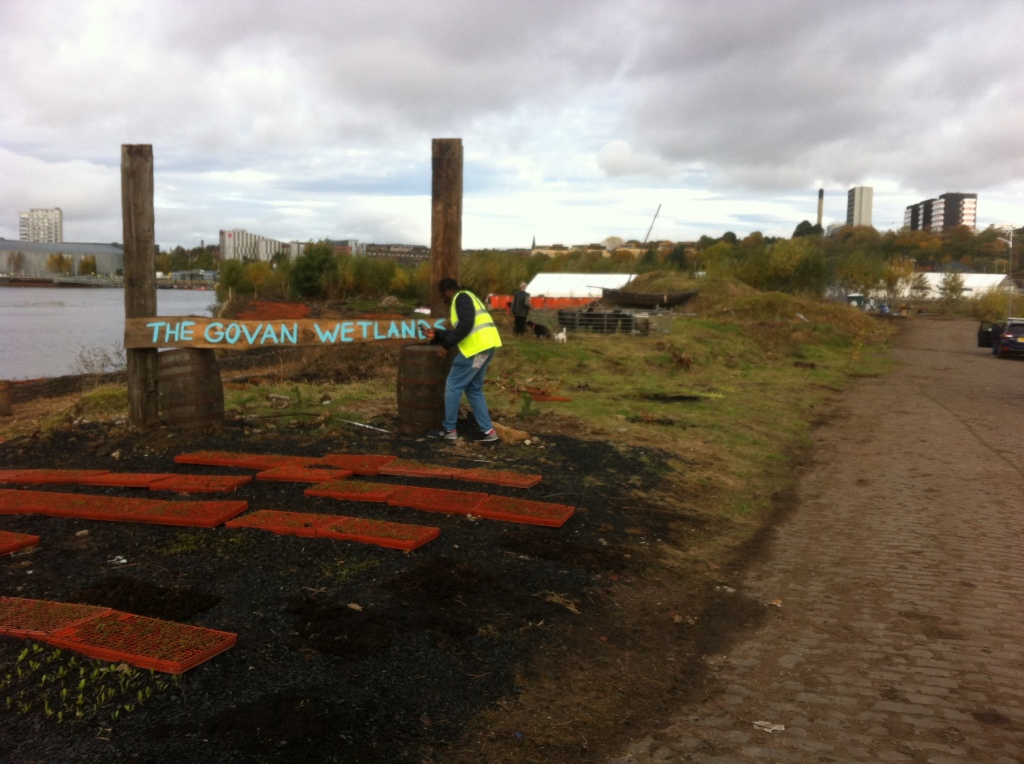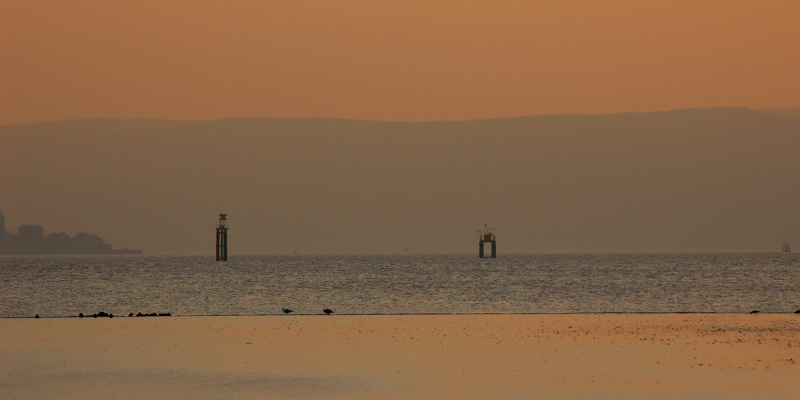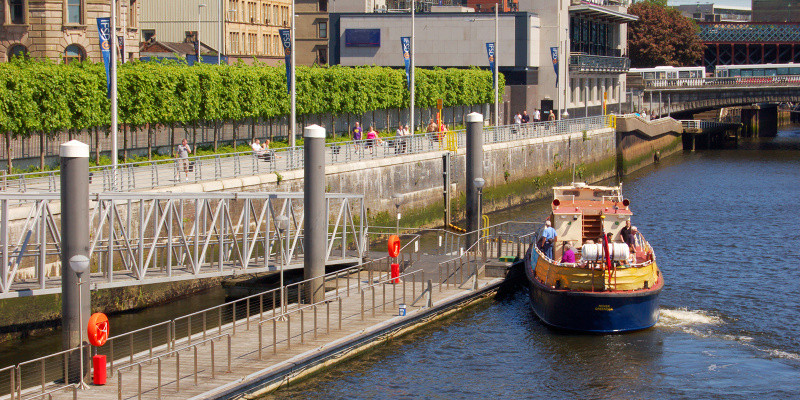With COP26 in Glasgow now over, collectively pausing for breath, it seems like a good time to reflect on both our own COP26 related activity and our pandemic experience.
Through the Pandemic
As with many people Covid-19 forced us into working almost entirely from home, relying on video conferencing instead of face-to-face meetings. Yet in that time so much progress has still been able to be made on our key projects and initiatives.
We have launched a mapping process for our Turning the Tide On the Clyde programme through a new collaboration with Glasgow Caledonian University, we have launched a conversation on Clyde sustainable shipping (which will grow and expand further post-COP26) and we undertook to bring a major art installation to Govan for COP26…

COP26 and NO NEW WORLDS
For us the LED light sculpture installation, spelling out the words “NO NEW WORLDS” at Govan Graving Docks during COP-26, has been multi-dimensional. The initial inspiration for Still/Moving (A Devon-based artist collective) who created the installation was to highlight the link between colonialism and climate change and so it was important for them as well as CDPI to bring it to COP26 given the legacy of colonialism in Glasgow and on the Clyde. For us it also highlights the plight of Govan’s forgotten derelict dry docks which are only now starting to have a new lease of life with an urban growing project being delivered by Seawater Solutions. That represents a seismic shift in the narrative about the future of the docks. The spectre of up to 750 flats in high rise blocks that we successfully challenged – through years of advocacy, networking and collaboration with like-minded (and some not so like-minded) people – no longer hangs over Govan’s waterfront. The conversation now is about heritage, environmental concerns and the space needs of the community – a conversation changed and driven by our collaborative network and Govan Docks Regeneration Trust’s “Govan Voices” consultation.
NO NEW WORLDS also serves as a pilot for an annual “official” art installation for our Turning the Tide On the Clyde programme. Not itself part of Turning the Tide On the Clyde and the programme development process – but an example of the kind of activity that the programme might include.
Alongside this we welcomed STORM and Little Amal to join hands at the Govan waterfront on 10th November as the crowds followed their procession from Water Row to Stag Street at the graving docks. Little Amal represents the remarkable story of a journey all the way from Syria, while STORM (originally created for Scotland’s Year of Coasts and Waters) a goddess of the sea is calling upon us to take care of our coasts and oceans. It was a privilege to be part of their journeys for COP26 and maybe one day we will see them meet on the Clyde again. This too an exemplar of the kinds of artistic and cultural activity that might be included in the Turning the Tide On the Clyde events programme in the future.
[NO NEW WORLDS was first installed on the Mountbatten Breakwater in Plymouth to mark the 400th anniversary of the voyage of the Mayflower. You can follow the story of the Glasgow installation on the NO NEW WORLDS COP26 Glasgow Facebook Page.]
Getting NO NEW WORLDS to Glasgow was a huge logistical, planning and fundraising exercise that involved so many people and hurdles – including some unsuccessful funding applications and repeated rethinking of plans. However as a catalyst for so many conversations and engagement across all areas of our projects and collaborative work (and although we had unsuccessfully applied for exhibition space in the COP26 Green Zone), it made sense in the end for us to put our entire COP26 activity focus into NO NEW WORLDS.
There has been so much going on around COP26 – a deluge of diverse activities – and we ourselves have only scratched the surface in finding our what else had been going on in Glasgow the past couple of weeks. Plenty to read and review in the weeks to come.

Research and Regeneration
We were also honoured to present to a University of the West of Scotland COP26 research seminar in Film City Glasgow on 5th November looking at artistic intervention and waterfront regeneration. This included a tour of the graving docks to see the NO NEW WORLDS installation up close and also see the fantastic work Seawater Solutions and Blue Green Glasgow have been doing to reanimate the unlisted part of the site. It’s really encouraging to see a shift in the regeneration narrative as we consider the impact of climate change on our waterfronts and the need for greater community involvement in the planning process. That said it is clear that modern maritime and light-industrial use of the waterfront, and especially sites like the graving docks, need to play a more central and prominent role in that narrative – along with inroads being made to introduce water based public transport.
It is encouraging to also see a rethink of plans for the vacant Glasgow Harbour site to the West of the River Kelvin. Gone are the proposals for tower block flats on the waterfront, cinema, casino and retail. The proposal now is for a wellbeing spa, vertical farm (enclosed in glass houses) and renewable energy systems (https://www.insider.co.uk/news/property-deal-signed-100-million-25442265). Although we would have preferred to see more maritime focus on this site, the new proposal certainly represents a step in the right direction and is well in line with the long-term opportunities for Glasgow that our COP26 legacy presents.

Mapping the Clyde
Our collaboration with Glasgow Caledonian University has seen postgraduate student Lindsay Robbins join us as Project Manager for the Turning the Tide On the Clyde programme and mapping process. Starting with an Innovation Voucher we have now moved on to the second phase supported by a Student Placement Voucher – both funded through the Scottish Funding Council. The process is all about identifying and mapping the existing resources, activities, stakeholders, etc along the tidal river and firth of Clyde that are relevant to developing a listing of events, things to see and do and places to visit in the region. It will eventually cover everything from festivals and community events to local businesses and visitor attractions, as well as promoting and raising the profile of the Clyde as a global destination. While it will keep a core maritime theme in line with the Clyde’s rich heritage, anything happening on or connected to the waterfront environment will also be relevant.
Turning the Tide On the Clyde has drawn much inspiration from London’s Totally Thames festival, which likewise includes independent artistic activities/installations in its programme of events running annually through September. Although Turning the Tide On the Clyde will also be an annual programme, it will run throughout the year with the main focus being on summer activity. It will also not simply replicate Totally Thames on the Clyde – but rather will be something very unique to the geography, culture and heritage of the Clyde – and shaped to a great extent by our stakeholders and communities.
We look forward to presenting a pilot programme of events for Turning the Tide On the Clyde in 2022.

Clyde Sustainable Shipping
The inspiration for this goes all the way back to 2016 when we were approached by a group of people interested in building a fully working, sailing replica of the Cutty Sark and who had identified Govan Graving Docks as an ideal site to build it – in one of the dry docks.
Local politics among other things got in the way and the Cutty Sark 2 project eventually moved to Portugal, however we had been captivated by their ambition to operate the replica ship as a sail cargo vessel. Their goal was to carry relatively small (certainly by TEU shipping container standards) cargo consignments of non-perishable goods – recognising the Cutty Sark original use as a tea clipper but also looking at ways to make shipping more sustainable and reduce CO2 emissions. This led us to look more into existing sail cargo projects and develop networks with people looking at sustainable shipping more broadly – including innovative new fuels and retrofitting of specially designed wind propulsion onto larger ships. This led us to build links initially with Fairtransport and Fair Winds Trading Company but more recently with Smart Green Shipping and various marine engineers and academics at the cutting edge of technological solutions to eliminate CO2 emissions from shipping.
Globally, shipping of goods by sea has a carbon footprint comparable to Germany (about 3-4% of global greenhouse gas emissions) and that’s before factoring in passenger and cruise shipping much less the sustainability of build and maintenance processes (it all starts with mining iron ore for the steel production – a process that globally is still heavily dependent on coal!). Even less obvious things like ocean microplastic from hull paint erosion are part of the overall environmental impact of shipping. We also need to consider the impact of the volume of goods being shipped. In the UK we only have to look at the country of origin of foods in our weekly shop – and see the country of origin of fruit and vegetables that could grow in our own climate but have come from the other side of the world. So sustainable shipping can’t just look at boats and their fuel – there’s a whole supply chain that we all support and we can use our spending power to influence change.
In January 2021 we launched a series of webinars exploring issues relevant to promoting sustainable shipping on the Clyde and we were delighted to host a number of expert guest panellists. We’ll be picking this up again post-COP26 as well as continuing to look at putting together a working group on Clyde Sustainable Shipping.
The Clydebank Declaration at COP26, signed by 22 countries including the UK, has set out to establish at least six green shipping corridors by 2025. In due course our Clyde Sustainable Shipping project will also consider what opportunities this presents for the Clyde.
A fifth of the world’s ships were built on the Clyde at its peak and so it would be ironic for the Clyde to be the location of international agreements to improve shipping’s environmental impact without the great maritime river playing a key role in the future. We won’t ever see Post-Panamax container ships or anything of similar scale being launched or docking on the upper Clyde but there are so many opportunities for build and operation of smaller vessels – with the focus on technology and innovation. And let’s not forget the role the Clyde played in construction of the Queen Elizabeth Class aircraft carriers. Far too big to actually launch fully assembled in Glasgow but component parts can still be fabricated for other vessels and assembled in large enough dry docks – whether in Rosyth or using Inchgreen dock – and not just for naval vessels but any that use a modular design.
Clyde.Scot
Clyde.Scot is a digital brand platform that we are in the process of developing. Very broadly the aim of the platform is to promote the river and firth of Clyde as maritime region and provide a key information portal. Hosting the Turning the Tide On the Clyde programme it will also look at industry, regeneration, the economy and environmental issues with a community-centric approach to developing the content (taking in geographic communities, communities of interest as well as for example business/industry and research/education communities). The aim is that in time it will be the “go to” web resource for information about the river and firth of Clyde region.

Building on the NO NEW WORLDS Momentum
Throughout 2022 we will undertake a community and stakeholder outreach and engagement programme in the River and Firth of Clyde Region to build on the message of NO NEW WORLDS. This will be a conversation about the implications of climate change for the Clyde as a maritime and marine recreational/tourism region. Although a distinct project in itself it will nevertheless have longer-term implications especially for our Turning the Tide On the Clyde programme and our Clyde Sustainable Shipping project – creating research that will support them. A body of research will be developed from this that will eventually be made available on the Clyde.Scot web portal.
How You Can Get Involved
Our community is key to our projects and their relevance. To be a fully engaged part of our community you can follow us on social media, subscribe to our mailing list and take part in our occasional surveys and consultation activities. However we cannot run on fresh air – you can also support CDPI financially as an associate member for £5 a month for individuals and £20 a month for SMEs and non-profit organisations. We’re in the process of building a critical mass of associate membership base that will enable us to develop associate membership benefits (such as discounts and VIP access to Clyde attractions, web services, etc).
Corporate Partnerships
We also have opportunities for corporate sponsorship of our work. We don’t have a set sponsorship package but can discuss tailored sponsorship arrangements on a case-by-case basis. Sponsorship can be of CDPI as an organisation or can be tied to one of our projects or an event depending on the synergy. We won’t enter into sponsorship arrangements with organisations that don’t satisfy strong ethical and environmental criteria. Again, this will be looked at on an individual basis.
Our Social Media Channels:
CDPI: Facebook | Twitter | LinkedIn
Turning the Tide On the Clyde: Facebook | Twitter
Clyde.Scot: Facebook | Twitter
NO NEW WORLDS COP26 Glasgow: Facebook
Acknowledgments for Our COP26 Activities
None of this has (or could have happened) in a vacuum and has been made possible by vital contributions from more people than we can count. To name a few:
Martin Hampton, Leonie Hampton and Laura Hopes from Still/Moving; Farhana Yamin; John Kerr; The STORM production team at Vision Mechanics; the Walk With Amal team; Helen Kyle at Stage Scotland; Louisa Taylor and the team at Studio FV; Police Scotland and the COP26 security; Glasgow City Council; Contributors to the crowdfunding campaign; Associate members of CDPI; Daniel Baxter, Dr Julie Roberts and Dr Caroline Gallagher from Glasgow Caledonian University; Prof. Katarzyna Kosmala and Prof. Graham Jeffrey at University of the West of Scotland; Liz Gardiner at Fablevision; Lindsay Robbins, CDPI. We would also like to acknowledge and thank Harry O’Donnell at New City Vision for granting permission to install the NO NEW WORLDS sculpture on Govan Graving Docks.
Iain McGillivray
Executive Director
CDPI
